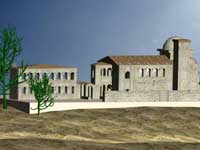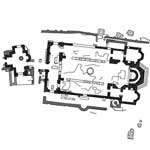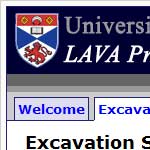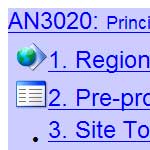Methodology and Innovation
Pedagogical concerns would suggest that students often learn well in an environment where they are able to explore a subject in a way that allows them to make discoveries and integrate these discoveries with their own past experiences. In LAVA we aim to apply this constructivist approach to learning in the subject area of archaeology. In doing so, we make use of a varied selection of software and technologies.
An ideal environment for students to learn archaeological methodology is through the experience of cooperating together in real archaeological excavation projects. These projects are, however, expensive to undertake and, given the relative scarcity of student places, real world excavation experience is not always possible. The field of archaeology lends itself to augmentation using virtual reality and other multimedia. This type of augmentation has been used by the software developed as part of the LAVA project to allow students to view virtual representations of archaeological projects and material culture and to provide representations of the context within which the material was discovered.
The innovation developed by the LAVA project can be seen in the integration of multimedia materials and gaming methodologies into a traditional learning management system. Using the Module Management System (MMS) learning management system developed by the School of Computer Science at The University of St Andrews, the LAVA project has overseen the development of the following learning resources:
- Scenario Resource:
 The scenario resource provides a number of typical excavation scenarios for students to work through. In the initial proof of concept implementation, resources relating to the Sparta Basilica Project undertaken by the British School at Athens have been developed. The scenario resource allows students to study archaeological issues within the context of actual fieldwork.
The scenario resource provides a number of typical excavation scenarios for students to work through. In the initial proof of concept implementation, resources relating to the Sparta Basilica Project undertaken by the British School at Athens have been developed. The scenario resource allows students to study archaeological issues within the context of actual fieldwork.- Excavation Simulator:
 The excavation simulator provides a realistic and engaging setting to allow students to review an entire excavation site and the material culture contained within it. Making use of a familiar web interface and innovative 3D first person gaming environment, the excavation simulator provides a collaborative environment in which students are able to build a shared understanding of the excavation environment.
The excavation simulator provides a realistic and engaging setting to allow students to review an entire excavation site and the material culture contained within it. Making use of a familiar web interface and innovative 3D first person gaming environment, the excavation simulator provides a collaborative environment in which students are able to build a shared understanding of the excavation environment.- Research Framework:
 Comprehensive guidance is provided to students through an associated project web site,
allowing learners to
build
up an understanding of the working practices and research methods they will need to employ in order to successfully manage an excavation project.
Comprehensive guidance is provided to students through an associated project web site,
allowing learners to
build
up an understanding of the working practices and research methods they will need to employ in order to successfully manage an excavation project.- Groupware Tools:
 By creating
groupware resources specifically designed to support document sharing, communication and advanced presence, the LAVA project will enhance the groupware facilities MMS can offer to other learning scenarios.
By creating
groupware resources specifically designed to support document sharing, communication and advanced presence, the LAVA project will enhance the groupware facilities MMS can offer to other learning scenarios.
The heart of the LAVA project is the development of a simulation where groups of learners can organise and participate in virtual archaeological fieldwork. The simulation is divided into a series of phases which are managed by the MMS learning management system. Each of the phases corresponds to the lifecycle of an archaeological fieldwork project and sets a series of challenges for the students to overcome. In our initial virtual excavation project, materials from the excavation work on the Sparta Basilica carried out by the British School at Athens have been used.
One of the key features of the software developed by the LAVA project is its applicability to other domains. All four software components developed have been developed independently of content and can be used in alternative domains, for example in Geography and Geosciences, or with alternative content to provide additional virtual excavation projects.

